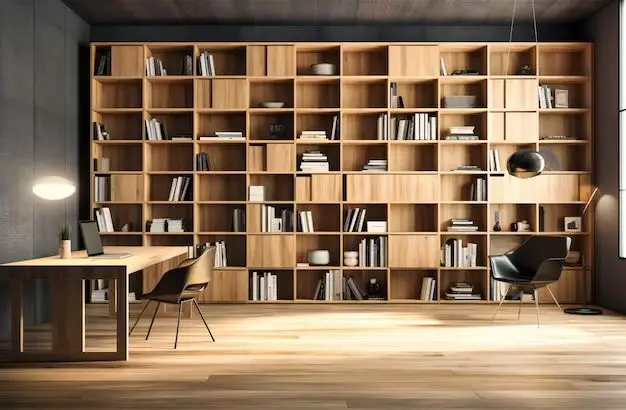When looking for a bookshelf to hold a large book collection, the type of shelving is an important consideration. The term used to describe a large bookshelf depends on its specific features and capacity.
Page Contents
Common Terms for Large Bookshelves
Here are some common terms used for big bookshelves:
- Library bookcase – This typically describes a tall, multi-shelf unit that offers substantial storage space. Library bookcases are designed to hold hundreds or even thousands of books.
- Barrister’s bookcase – This refers to a luxurious, ornate bookshelf that features glass doors and intricate woodwork. Barrister’s bookcases are associated with law offices and stately libraries.
- Modular bookcase – For maximum flexibility, many choose modular bookshelves that can be rearranged or expanded as needed. The components connect together in different configurations.
- Built-in bookcase – Built-in shelving makes use of available wall space for floor-to-ceiling bookshelves. This customized option provides abundant room for books.
- Ladder bookcase – A ladder shelf uses a sliding wooden ladder to reach the highest levels. This allows books to be stored up to the ceiling.
Factors to Consider
When selecting large-scale bookshelves, here are some key factors to keep in mind:
- Book capacity – Carefully estimate how many books you need to accommodate now and in the future. Measure linear feet or shelf space required.
- Room dimensions – Make sure the bookcase dimensions are appropriate for the available floorspace or wall space in your room.
- Weight capacity – Sturdy materials and construction are needed to support the heavy weight of a large book collection. Check weight limits.
- Shelving height – Standard bookcases are about 6-7 feet tall. Full-height built-ins may reach up to 9 feet. Consider your reach when shelving and retrieving books.
- Shelf depth – Deep shelves around 12 inches can hold rows of books. Shallower shelves work better for display. Make sure shelves are deep enough to suit your books’ sizes.
- Style – Choose a style that aligns with your existing decor, whether modern, traditional, rustic, industrial, or other aesthetic.
Large Bookcase Materials
Large bookshelves are commonly constructed from these durable materials:
- Solid wood – Oak, maple, walnut, and ash are all attractive hardwood options that stand up well to heavy books. Rich wood grain adds warmth.
- Engineered wood – Plywood, MDF, and melamine are very stable and affordable engineered wood products suitable for bookshelves.
- Metal – Steel and aluminum bookshelves introduce an industrial vibe. Powder-coated metals resist chipping and corrosion.
- Laminate – Particleboard shelving with a laminate finish offers an inexpensive solution. It’s weaker than solid wood but sturdy enough for books.
Typical Bookcase Dimensions
Standard bookshelf dimensions for large book storage include:
- Height: 6 to 9 feet
- Width: 3 to 6 feet
- Depth: 10 to 14 inches
- Shelf thickness: 0.75 to 1 inch
- Shelf spacing: adjustable from 12 to 18 inches
However, many large bookcases are customizable and made-to-order for a perfect fit.
Choosing Bookshelf Backing
Another decision is whether to get an open-backed or closed-back bookcase. Here is a comparison:
| Open-Backed | Closed-Back |
|---|---|
| Lets you access books from either side | Provides sturdy backdrop and prevents sagging |
| Allows for wall mounting | Hides clutter and mess behind books |
| Lightweight design | Very durable and stable |
| Lower cost | Often made from higher-quality wood |
Popular Large Bookcase Designs
Here are some classic large bookcase designs perfect for expansive book collections:
- Modern – Clean lines, minimalist metal or wood
- Rustic – Distressed wood with sliding barn doors
- Traditional – Cherrywood with glass doors and ornate molding
- Industrial – Steel or wood with exposed hardware and pipes
- Built-in wall – Custom floor-to-ceiling shelves for a seamless look
Tips for Styling Large Bookshelves
Once filled, a large bookcase becomes a focal feature. Here are styling tips:
- Group books by color, height, or genre for visual interest
- Use bookends to keep rows tidy and upright
- Layer in book-themed accents like globes or statues
- Add lighting above or inside the bookcase for readability
- Keep lower shelves more organized and style upper shelves more artfully
- Mix in some horizontal stacking and vertical grouping of spines
- Dust regularly and clean with appropriate wood polish
Conclusion
The most common terms used for sizable bookshelves include library bookcases, barrister’s bookcases, modular designs, built-ins, and ladder bookshelves. When selecting oversized shelves, consider book capacity, dimensions, weight limits, height, depth, and style. Popular materials include wood, metal, and laminates. Leave ample room for growth and use strong construction. Finally, creatively style large book storage to highlight your collection.
